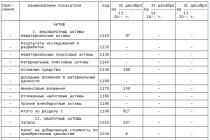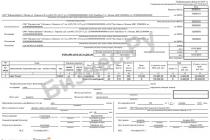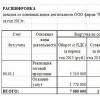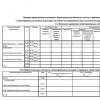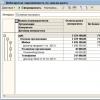net assets. Competent determination of the value of net assets.
Each business entity must be able to calculate the value of net assets.
The assets of an organization are everything that it owns (property, investments, obligations of third parties to it), everything that generates profit and that can be converted into cash.
Along with the specified property and investments, the organization in the course of its existence always has obligations to third parties. Net assets (also use the prefix "net", net assets) - this is all that remains at the disposal of the company after it pays off all its obligations. The term "own funds" is used as a synonym in the economic literature and some normative sources. In essence, this is what the organization owes to business owners, founders, in economic terms, the so-called “business price”, since the owners of the company in the event of its liquidation, bankruptcy can count on repaying debts to them last, after the organization’s obligations to other creditors are repaid.
On the other hand, own funds act as a financial guarantee of the organization's fulfillment of obligations to third parties. In socially significant activities, the requirements for the amount of equity in the relevant area (for example, in banking, insurance) are very high.
This concept has an extremely important practical application, in connection with which this material is devoted to the study of the algorithm for assessing the value of the net assets of LLCs and JSCs and the analysis of some important cases of application in activity. Further in the text of the Federal Law "On Limited Liability Companies" dated 08.02.1998 N 14-FZ will be referred to as "FZ No. 14-FZ", the Federal Law "On Joint-Stock Companies" dated 12.26.1995 N 208-FZ - "FZ No. 208-FZ".
Note that currently there is a single The procedure for determining the value of net assets, approved by Order of the Ministry of Finance of the Russian Federation of August 28, 2014 N 84n (hereinafter referred to as the Procedure) for various organizational and legal forms of legal entities - JSC, LLC, state and municipal unitary enterprises, production cooperatives, housing savings cooperatives, business partnerships, with the exception of credit organizations and joint-stock investment funds.
Note. The credit institution calculates, in accordance with the procedure established by the Bank of Russia, the amount of its own funds (capital).
How net assets are calculated
The value of net assets is determined as the difference between the value of the organization's assets accepted for calculation and the value of its liabilities accepted for calculation.
Let's figure out what we exclude when performing calculations. First of all, we do not take into account accounting items recorded on off-balance accounts (for example, leased fixed assets, goods and materials accepted for safekeeping, securing obligations and payments).
For the calculation of assets, we do not accept the accounts receivable of the founders (participants, shareholders, owners, members) for contributions (contributions) to the authorized capital (authorized fund, share fund, share capital), for payment of shares.
For the calculation of liabilities, we do not accept deferred income recognized by the organization in connection with the receipt of state assistance, as well as in connection with the gratuitous receipt of property.
Everything else is included in the calculations.
The calculation is carried out according to accounting data. To do this, we need a balance sheet. This follows from paragraph 7 of the Order.
In its most simplified form, the formula for calculating the value of net assets will look like this:
NA = Assets to be settled - Liabilities to be settled
Using the provisions of the Procedure, as well as the structure of the balance sheet, we obtain the following detailed formula:
NA = (Section I + Section II - MC Debt) - (Section IV + Section V - BP Income) = = Section III - MC Debt + BP Income,
where NA is the value of net assets;
Section I* - total for section. I (non-current assets);
Section II - summary of section. II (current assets);
Section III - summary of section. III (capital and reserves);
Section IV - summary of section. IV (long-term liabilities);
Section V - total for section. V (short-term liabilities);
Debt of the Criminal Code - the debt of the founders on contributions to the authorized capital;
BP income - deferred income (credit balance of account 98 “Deferred income, sub-accounts “Free receipts”, “State Assistance”).
(*meaning sections of the balance sheet).
AOs must evaluate their net assets on a quarterly basis at the end of each quarter, as well as at the end of the year. LLCs can only evaluate at the end of the calendar year.
Why calculate net assets?
Reason 1. Financial control over the state of affairs
The indicator is used to control the financial condition, reflects the efficiency of the functioning of an economic entity.
First of all, the ratio of net assets to the size of the authorized capital (UK) is carried out. Both of these indicators are very important in relation to each other. The latter should be larger. Otherwise, the law prescribes certain changes to be made within a specified period.
So, in the annual report of the organization are indicated:
1) the dynamics of changes in both net assets and the authorized capital of JSCs and LLCs for the last three completed financial years, including the reporting year, or, if the organization exists for less than three years, for each completed financial year;
2) the results of the analysis of the causes and factors that, in the opinion of the sole executive body of the company, the board of directors, led to the fact that the ratio of indicators is violated;
3) a list of measures that are proposed to be implemented to remedy the situation.
A special feature for AOs: they must make such an assessment of the ratio of indicators quarterly at the end of each quarter. If the net assets turn out to be less than the charter capital by more than 25 percent at the end of three, six, nine or twelve months of the reporting year following the second or each subsequent reporting year, at the end of which the amount of the authorized capital turned out to be larger, the joint-stock company is obliged to place in the mass media, in which data on the state registration of legal entities is published, a notice of a decrease in the value of its net assets twice with a frequency of once a month.
The creditor of the company, if its rights of claim arose before the publication of the said notice, no later than 30 days from the date of the last publication of such notice, has the right to demand from the joint-stock company the early fulfillment of the corresponding obligation, and if it is impossible to fulfill it ahead of schedule, the termination of the obligation and compensation for the related losses. The limitation period for applying to the court with this requirement is six months from the date of the last publication of such notice.
The court has the right to refuse to satisfy such a claim of the creditor if it is proved:
1) the rights of creditors are not violated by such a reduction;
2) the security provided for the proper performance of the relevant obligation is sufficient.
The value of net assets at the end of two financial years in a row cannot be less than the Criminal Code (clause 4 of Article 30 of the Federal Law No. 14-FZ, clause 6 of Article 35 of the Federal Law No. 208-FZ). Otherwise, no later than six months after the end of the relevant financial year, one of the following decisions must be taken:
1) on reducing the authorized capital of the company to an amount not exceeding the value of its net assets;
2) on the liquidation of the company.
The Civil Code also provided an opportunity in this case to go the "reverse" way - to increase net assets to the size of the authorized capital (clause 4 of Article 90 of the Civil Code of the Russian Federation, clause 4 of Article 99 of the Civil Code of the Russian Federation).
Possible ways of such an increase: making additional contributions to the property of the company, using borrowed funds, writing off bad debts, increasing profits and reducing losses, revaluing, issuing shares. Each of these paths has its own difficulties. The use of financial assistance increases the amount of liabilities. The increase in profits, revenues is limited by a lack of resources and limited sales markets, etc. You can, on the contrary, take the path of reducing the amount of costs, lowering the level of obligations. Such a reduction can be achieved through their restructuring (changing repayment schedules, deferring payments, by paying off part of the debts, which, in turn, is possible if there is a sufficient amount of free funds that can be used to fulfill the organization's obligations. For these purposes, it is possible, in particular, to improve work in the direction of collecting receivables, including organizational, judicial work with counterparties, the sale of debts to third parties, mutual offsets, etc.
At the same time, it is worth mentioning the so-called “imaginary assets” - in order to improve performance or for other reasons (technical errors, insufficient qualifications of responsible persons), assets are reflected in the accounting records that should not be reflected there on the date of the assessment. Such "imaginary equity" does not bring real profit, it has "value" only on paper. What to hide, sometimes this is done in order to achieve compliance of the financial performance of the organization with regulatory requirements (for example, to carry out activities in licensed areas), to obtain borrowed funds, including credit funds, for a kind of “adjustment” of tax consequences for business.
Factors that artificially inflate the value of net assets include, in particular, uncollectible receivables that must be written off (for example, the limitation period has expired, the counterparty has ceased to exist without succession), fixed assets unusable due to depreciation, or intangible assets unusable due to moral obsolescence, as well as investments in subsidiaries conducting unprofitable activities, when the value of such a subsidiary due to unprofitability lower than the size of investments in it, etc.
Reason 2. Dividend payment
As stated in paragraph 1 of Article 29 of Federal Law No. 14-FZ, an LLC is not entitled to make a decision on the distribution of its profits if, at the time of the decision, the amount of net assets is less than its authorized capital and reserve fund or becomes such as a result of such a decision.
Similar restrictions are established by law for JSCs that are not entitled to make a decision (announce) on the payment of dividends on shares and pay declared dividends, if, on the day of making such a decision / on the day of payment, respectively, the amount of the net assets of the JSC is less than its authorized capital, and the reserve fund, and the excess of the liquidation value of the placed preferred shares over the nominal value determined by the charter, or will become less than their size as a result of such a decision / as a result of the payment of dividends (paragraphs 1, 4 of Article 43 of Federal Law No. 2 08-FZ).
Reason 3. To calculate the actual value of the share
The actual value of the share of an LLC participant corresponds to the part of the net asset value proportional to the size of its share (clause 2, article 14 of the Federal Law No. 14-FZ).
In what cases is it necessary to calculate it?
Firstly, in the case of the acquisition of a share by the Company at the request of its participant, when its alienation to third parties is prohibited by the constituent documents, and other participants refused to acquire it, or, in accordance with the charter, it is necessary to obtain consent to the alienation, but it was not received.
Secondly, in cases of acquisition of a share by a company at the request of its participant who voted against the adoption by the general meeting of a decision to make a major transaction or to increase the authorized capital, in accordance with paragraph 1 of Art. 19 FZ No. 14-FZ, or did not take part in the voting.
In the two indicated cases, the period for payment is three months from the date of the occurrence of the corresponding obligation, unless otherwise specified in the charter. Its size is determined on the basis of the data of the company's financial statements for the last reporting period preceding the day of filing the relevant claim.
Thirdly, in cases of exclusion of a participant, when his share was transferred to the LLC.
Fourthly, when the consent of the participants of the LLC to transfer the share to the heirs, successors, the buyer at public auction, the founders (participants) of the liquidated legal entity, having rights in rem to its property or rights of obligation in relation to this legal entity, has not been received.
Fifth, in the event of a participant's withdrawal from the company (if the Charter does not contain a corresponding prohibition) by alienating his share in the LLC.
Sixth, in the case when the LLC pays the creditors of its participant the actual value of its share at the request of the creditors.
The payment is made from the difference between the value of the company's net assets and the size of its authorized capital. If such a difference is not enough, the obligation to reduce the authorized capital by the missing amount is prescribed.
Reason 4. Increase in authorized capital
An LLC may increase its charter capital at the expense of its property, and (or) at the expense of additional contributions from its participants, and (or), unless it is prohibited by its charter, at the expense of contributions from third parties accepted by the company.
If the increase occurs at the expense of the property belonging to him, one cannot do without calculating the amount of net assets, since clause 2 of Art. 18 FZ 14-FZ establishes the rule: the amount by which the authorized capital is increased at the expense of the property belonging to it should not exceed the difference between the net assets of the LLC and the amount of the authorized capital and its reserve fund.
JSC may increase its authorized capital by increasing the par value of shares or by placing additional shares. At the same time, an increase by placing additional shares can be carried out at the expense of its property, and if it goes through an increase in the nominal value of shares, then it is carried out only at the expense of the JSC's property.
For cases of increasing the authorized capital of a joint-stock company at the expense of its property, a rule is established similar to the rules for an LLC: The amount by which the authorized capital of a joint-stock company is increased at the expense of the property of a joint-stock company must not exceed the difference between the amount of net assets and the amount of the authorized capital and its reserve fund (clause 5, article 28 of the Federal Law No. 208-FZ).
Reason 5. Decrease in authorized capital.
Federal Law No. 208-FZ establishes for JSCs the possibility of reducing the authorized capital, and also establishes cases of its mandatory reduction. In this case, one cannot do without the calculations to which our article is devoted.
Firstly, in this case, the rule must be observed: the ratio of the amount by which the authorized capital is reduced to its size before reduction cannot be less than the ratio of the funds received by shareholders and (or) the total value of equity securities acquired by them to the amount of net assets, the value of which is determined according to its accounting data as of the reporting date for the last quarter preceding the quarter during which the board of directors (supervisory board) decided to convene a general meeting of shareholders, the agenda of which contains the issue of reducing the authorized capital (p .3 article 29 FZ 208-FZ).
Secondly, the law prohibits a joint-stock company from making a decision to decrease if, on the day of its adoption, the amount of its net assets is less than the sum of its authorized capital, reserve fund and the excess of the liquidation value of the placed preferred shares over the nominal value determined by the charter, or becomes such as a result of actions carried out in accordance with the rules of paragraph 3 of Art. 29 FZ No. 208-FZ payment of funds and (or) alienation of issue-grade securities.
As you can see, the calculation of net assets is extremely important in the life of every business entity. Its indicators give the company reliability, strengthening its credibility in the market, expand the possibilities for attracting financial resources, and strengthen confidence in solvency and stability.
Using the calculation skills discussed in this article, an enterprise can respond to changing conditions in a timely manner, track negative trends, and flexibly overcome them. Management decision-making is possible in conditions of complete, objective and comprehensive information about the value of net assets and its dynamics. The duty of a joint stock company to provide any interested person with access to information on the value of its net assets is legally fixed. For LLC participants, as we know, the right to receive any information about the activities of the company, including indicators of the value of net assets, is secured. errors in the alienation of a share in the authorized capital of the company conducting litigation;
4) ;
5) ;
6) .

Our law firm provides various legal services in different cities of Russia (including Novosibirsk, Tomsk, Omsk, Barnaul, Krasnoyarsk, Kemerovo, Novokuznetsk, Irkutsk, Chita, Vladivostok, Moscow, St. chi).
We will be glad to see you among our clients!
Call or write right now!
Phone +7 (383) 310-38-76
E-mail address
Law firm "Vetrov and partners"
more than just legal services



